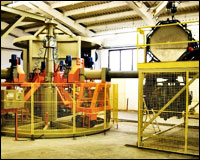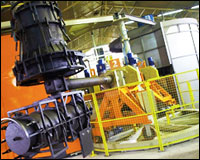| Home >
Production Process > Different Phases of Rotomolding Production |
Phases of Rotomoulding Process |
 Rotomoulding is probably the most cost effective way of producing large and hollow plastic parts. It yields seamless parts that boosts uniform wall thickness and deposition of more materials in the corners for shock absorbing. The finished parts are relatively stronger too, as the raw materials are not subjected to stress during production. Plus the molds used in the process are significantly cheaper than any other types and very little material is wasted using this process. The excess material can always be re-used.
Rotomoulding is probably the most cost effective way of producing large and hollow plastic parts. It yields seamless parts that boosts uniform wall thickness and deposition of more materials in the corners for shock absorbing. The finished parts are relatively stronger too, as the raw materials are not subjected to stress during production. Plus the molds used in the process are significantly cheaper than any other types and very little material is wasted using this process. The excess material can always be re-used.
The Process of Rotomolding can Basically be Divided into Four Phases:
- Loading
- Heating
- Cooling
- Unloading the Mold.
Loading:
First, the desired quantity of the polymer to be used is measured and put into the mold (usually in its powdered form).
Heating:
After the plastic material has been loaded, the molds are heated adequately in an oven and rotated slowly by a rotomoulding machine, both on the vertical and the horizontal axis till the plastic melts. This constant heating and rotation results in the even distribution of the material on the inner surface of the mold. Proper care must be taken during this phase so that the material is just immaculately heated. Overheating may decrease the strength of the polymer and under-heating will hamper in the even distribution of the molten material, resulting in bubbles, thereby impacting the product quality.
 Cooling:
Cooling:
The process of cooling is generally done by fan or in some cases by spraying water. This is the lengthiest process among all four. During this process the molten materials solidify and assumes the desired shape. Like the heating process, even cooling the molds must be maintained within a specific range. If the cooling is done too rapidly, it would result in excess shrinkage and produce warped parts. Some experts insist that the moulds should be kept rotating even during this cooling stage.
Unloading the Mold:
This is the last stage of rotomoulding process in which the moulds so formed are taken out by the operator. |
| |
| |
 |
